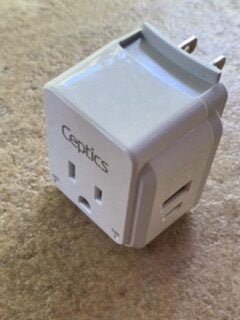I’ve talked a lot about electronic devices in other posts. Most folks will bring a cell phone for navigation and photography, a headlamp, maybe a Garmin InReach for safety. The more electronics that you bring, and rely on, especially on a longer trip, you have to answer the question – how do you keep electronic devices charged?
Save Power – switch of what you don’t need
The simplest solution of all is to switch off what you don’t need. If you are bringing a cell phone make sure it’s in airplane mode unless you actually are trying to get a signal. Cell phones’ GPS is separate from the cellular function and this will save a ton of power. If you are using a satellite device like a Garmin InReach, considering just turning it on when you need to, especially if you are really using the device for messaging. These simple power-saving techniques will reduce or eliminate the need you’ll have to recharge devices.
Batteries – the simple solution
If you have a device that takes batteries – the simple and reliable solution is to make sure they are full and that you have a spare set. Most commonly this will apply to a headlamp. This should be a pretty reliable method to ensure you have enough power. It is unlikely that 2 sets of batteries will run out before your next resupply point on a longer hike.
Recharge – battery pack or solar?
If you do need to recharge a device, then you can look at either solar or a battery pack. Unless you are hiking in some pretty open, sun-drenched areas I’d recommend a battery back. These are available in different capacities. I’d recommend a minimum of 10000mAh up to anything north of 25000mAh. Of course, the big difference is weight. There are plenty of chargers that have a small solar cell built into them, but these will not make a significant charging difference.

I’d recommend either a RAVPower or Anker – I currently have a cheap one I picked up on Amazon and although it’s rated the same as Keenan’s RAVPower, it only lasts about half as long. There is now a bewildering array of connection types from USB-A, micro USB, USB-C. I’d recommend at least having a power pack that can support USB-A and USB-C and then a decent set of cables to support your devices.
A new battery pack is likely to be my next purchase and I’m looking at either this RAVPower or this Anker. The Anker is slightly lighter for about the same power.
Whatever you have – make sure it is fully charged before you leave.
If you are all set with electronics, check out other basic gear needs.
Cables – optimizing the spaghetti mess

I have three electronic devices I regularly take with me. An iPhone, Apple Watch, and Garmin InReach – they all have different connections. After a lot of research, I ended up with a pretty small cable set.
The cable at the top is a regular USB-A – micro USB cable. This I already had lying around at home. I use this primarily for charging the InReach. The cable at the bottom is a USB-A iPhone and iWatch combo. This allows me to charge both devices from a single cable. Works well and saves some space. The only improvement I would make here is a shorter cable if I could find one. In the middle is a USB-C to USB-A adapter. This is an added convenience to give me a few more charging options if I can plug into my wall charger.
Resupply stops – charging up

Normally if you are out for a couple of nights your battery back will be sufficient and you can just recharge it when you get home. However, if you are lucky enough to be doing a longer trip, you might have to recharge at a resupply location, where charging options are limited. Most folks will look for the lightest, high-power charger so that they can recharge their battery pack as quickly as possible. However, I selected a power charger that has the added flexibility of allowing it to be stacked. Often outlets are at a premium in cafes or shops, and although they are generous in allowing backpackers to recharge, my charger allows you to not ‘occupy’ the socket. It has USB-A and C for charging. You can see that once it’s plugged in, another device can be plugged into it. Very useful! For me it’s multi-purpose as I (used) to travel a lot it has interchangeable plugs for different countries.






